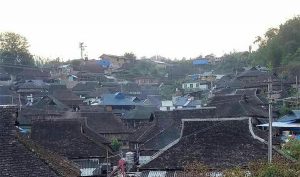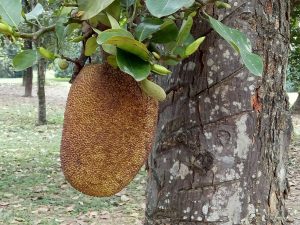Zhanglang Bulang Ethnic Minority Village, Xishuangbanna

Chinese Name: 章郎布朗古寨
Chinese Pinyin: Zhang Lang Bu Lang Gu Zhai
English Name: Zhanglang Bulang Ethnic Village
Keywords: Bulang Ethnic, Bulang Minority, Puer Tea, Bulang Ethnic Culture
Type: ancient village, ethnic minority, tea
Altitude: 1330 meters
Scenic Area: about 5.5 square kilometers
Opening Hours: all day
Location: Zhanglang Village, Xiding Town, MengMenghai County, Xishuangbanna,Yunnan Province
Zhanglang Bulang Ethnic Minority Village
Zhanglang Bulang Ethnic Minority Village(章朗布朗古寨) is the only one Bulang ecologic museum in China. The Bulang people have been inhabitants of the area for thousands of years. Zhang is elephant, and Lang means frozen in Dai language. Zhanglang is the place of elephants getting frozen. It enjoys long history, over a thousand years. It also keep the traditional culture and historic relics completely. Zhanglang village can take you back to know more about history. It is waiting for you to discover.
Chinese Name: 西双版纳傣族自治州勐海县西定乡章朗村
English Name: Zhanglang Village of Xiding Town in Menghai County, Xishuangbanna
Why is Zhanglang Bulang Ethnic Minority Village so special?
Zhanglang Bulang Village is like a living fossil, enjoying the ancient temple , ancient well and ancient trees. It carries not only the traditional culture of Bulang minority, but also the tea culture.
Where is Zhanglang Bulang Village?
It is located in Xiding Town of Menghai County, 70 km from Menghai County and 100 km from Jinghong City. It is surrounded by the primeval forest and wild tea trees.
How to Get to Zhanglang Bulang Village
There is no bus to Zhanglang Village. Travelers can drive or cycle to this ancient village.
Legend
Zhanglang means the place of elephants getting frozen in Dai language. 1400 years ago, Mahahong, the disciple of Sakyamuni, traveled around the world by riding elephant. When they came here, it rained cats and dogs, with hails. The rain did not stop until the night. They had to live in local Buddhist Temple. The elephant was frozen the next day. Mahahong named the village as Zhanglang to memory the contribution of elephant.
More Information about Zhanglang Village

Drive from Menghai County, and across Mengzhe Town, hillup the mountain, via Bada mountains, you can see the Zhanglang Village, with 70 kilometers from Menghai County. From afar, the Zhanglang Village with thousand years is hidden in the virgin forest. The top of mountain standing a pagoda with unique style.
Bulang Ethnic Minority
The Bulang ethnic (also known as Blang) are one of the ethnic minority groups of southwestern Yunnan province. There are approximately 90,000 Bulang people remaining in China. There’s the highest density of Bulang natives as well as the Lahu people in the Menglai area of southwest Yunnan. Many of these villages are easily accessible on a trip to Xishuangbanna. Nonyang is a town located in the Xishuangbanna prefecture and a few kilometers from Menghun, it’s one of the main spots for the Bulang people. Pass the mountains in Menghun and the territory extends to the Myanmar border. Most of the Bulang villages are over 1,500 meters above sea level. In many villages the traditional-style Bulang houses remain standing.
They believe in original religion in ancient time, and now believe in Buddhism. It is very secure there as there is no single crime in Zhanglang Village since the founding of People’s Republic of China.
Tea Culture of Zhanglang Village
Zhanglang tea is famous for its high-quality and long history. Tea is a kind of life style. For a thousand year, the village keeps the traditional tea culture. Zhanglang village is embraced by tea trees planted by their ancestors. Bada Ancient Tea Plantation is main plantation. It is a ideal place for you to get back and experience life.

Main Attractions
● Zhanglang White Elephant Temple(章郎白象寺)
According to the record of Pattra-Leaf Scripture which treasured up in Zhanglang Temple, the White Elephant Temple has a 1365 years history, with an area of 4 acres. There is a Temple, a mook room, a pagoda, and a Scripture library with more than 100 Pattra-Leaf Scripture. The whole Temple building group reflect the unique art style of Bulang Ethnic building style.
● Ancient well(千年古井)
There is a ancient well outside the Zhanglang Village with thousands of year. According to legend, a disciple of Sakyamuni passed away the village, and the weather is too hot, the elephant was intolerable thirst, so it dig a well with its long nose. The interesting is that the well never dried-up all around the year.
● Bada Mountains(巴达山)
Speaking of Bada, the Bulang people consider it as “where the immortals left footprints” in their language. It’s a famous place among tea fans in China and abroad. In 1962, Yunnan Institution of Tea found an ancient wild tea tree over 1700 year old in virgin forest beside Hesong Village in Bada, experts and tea fans hand been visiting this place almost every year since then. Bada obtains most of wild tea trees in Xishuangbanna, the original tea trees grow in an area over 6000 acres. There are also large artificial cultivation tea [FS:Page]plantation in Bada, which distribute in villages like Zhanglang, Manmai, Manpi and Manpana.
●Bulang Eco Museum(布朗生态博物馆)
Bulang Eco Museum is the first Eco Museum of Bulang Nationality in China and the world. It is located in Zhanglang Village, the border of China and Burma. It is a typical Bulang Village with 1400 years of history. There are ancient Buddhist Temple, ancient tea garden and ancient Dragon Mountain Forest. The ancient culture, living and working styles, moral values, folk customs such as production, marriage, funeral, house construction, sacrifice, diet still remains in Zhanglang Village. The museum collects the daily necessities, repair some ancient buildings and educate the villagers to protect their traditional customs. The villagers in the eco museum are more important element of the museum than natural scenery and exhibitions.
Recommended Tours
2 Days Xishuangbanna Ethnic Villages Hiking Tour from Bada to Zhanglang
6 Days XishuangBanna Tea Mountain Hiking Tour to Bada, Zhanglang, Xiding and Nannuo Tea Mountain
6 Days XishuangBanna Tea Culture and Ethnic Villages Hiking Tour from Bada to Xiding
Nearby Attractions
Jingzhen Octagonal Pavilion (Chinese name: 景真八角亭), an famous ancient Buddhism architecture in China, is one of the most important cultural relics in Xishuangbanna. Located in the Jingzhen Village, this pavilion is called Octagonal Pavilion which means a place to hold the holy religious ceremony.
Best Time to Visit
Belonging to tropical rainforest climate, Xishuangbanna’s dry season is from November to April the next year and rainy season is from May to October. It has long summer and no winter. With cool and pleasant four seasons, the best time for traveling Xishuangbanna is from October to April the next year.
Useful Travel Tips
●It is better to prepare some mosquito products and sun block in case of insects and sunlight.
●Respect the local customs of Bulang.
●Respect their belief to Buddhism.
●It is better to take T-shirt, short and slippers becauce it is too hot in Xishuangbanna.

 7 Days GolfingTour
7 Days GolfingTour
 8 Days Group Tour
8 Days Group Tour
 8 Days Yunnan Tour
8 Days Yunnan Tour
 7 Days Shangri La Hiking
7 Days Shangri La Hiking
 11 Days Yunnan Tour
11 Days Yunnan Tour
 6 Days Yuanyang Terraces
6 Days Yuanyang Terraces
 11 Days Yunnan Tour
11 Days Yunnan Tour
 8 Days South Yunnan
8 Days South Yunnan
 7 Days Tea Tour
7 Days Tea Tour
 8 Days Muslim Tour
8 Days Muslim Tour
 12 Days Self-Driving
12 Days Self-Driving
 4 Days Haba Climbing
4 Days Haba Climbing
 Tiger Leaping Gorge
Tiger Leaping Gorge
 Stone Forest
Stone Forest
 Yunnan-Tibet
Yunnan-Tibet
 Hani Rice Terraces
Hani Rice Terraces
 Kunming
Kunming
 Lijiang
Lijiang
 Shangri-la
Shangri-la
 Dali
Dali
 XishuangBanna
XishuangBanna
 Honghe
Honghe
 Kunming
Kunming
 Lijiang
Lijiang
 Shangri-la
Shangri-la
 Yuanyang Rice Terraces
Yuanyang Rice Terraces
 Nujiang
Nujiang
 XishuangBanna
XishuangBanna
 Spring City Golf
Spring City Golf
 Snow Mountain Golf
Snow Mountain Golf
 Stone Mountain Golf
Stone Mountain Golf












